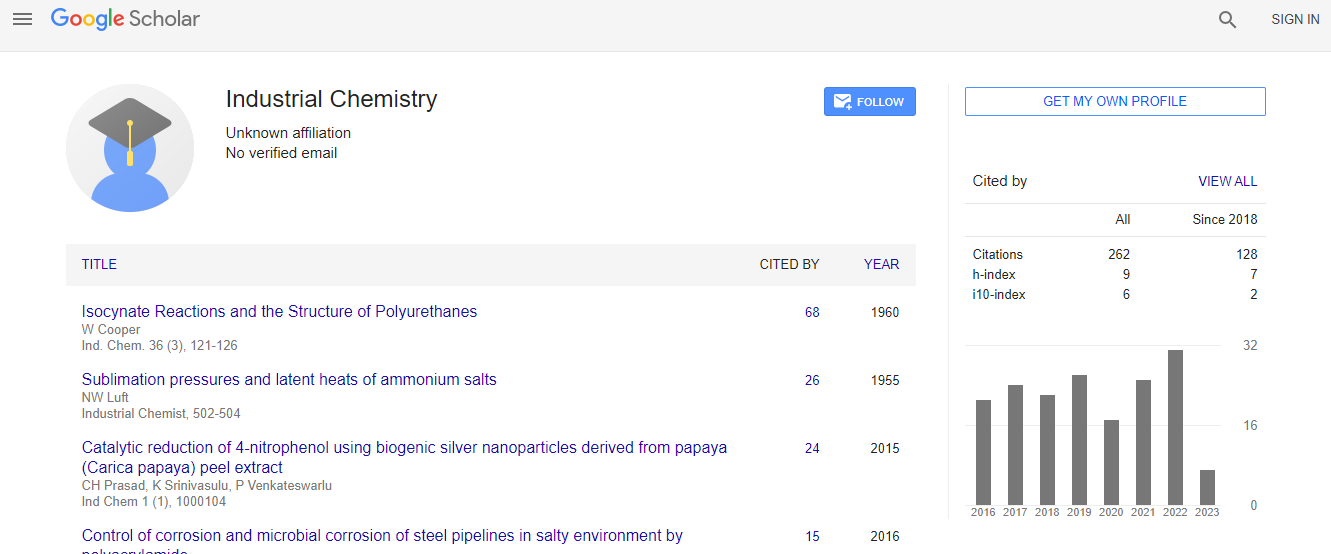Our Group organises 3000+ Global Conferenceseries Events every year across USA, Europe & Asia with support from 1000 more scientific Societies and Publishes 700+ Open Access Journals which contains over 50000 eminent personalities, reputed scientists as editorial board members.
Open Access Journals gaining more Readers and Citations
700 Journals and 15,000,000 Readers Each Journal is getting 25,000+ Readers
Google Scholar citation report
Citations : 262
Industrial Chemistry received 262 citations as per Google Scholar report
Indexed In
- Index Copernicus
- Google Scholar
- RefSeek
- Directory of Research Journal Indexing (DRJI)
- Hamdard University
- EBSCO A-Z
- OCLC- WorldCat
- Scholarsteer
- Geneva Foundation for Medical Education and Research
- Euro Pub
Useful Links
Recommended Journals
Related Subjects
Share This Page
Gold nanoparticles assembled on multilayer graphene sheets for surface enhanced Raman spectroscopy of glucose and related organic pollutants
17th International Conference on Industrial Chemistry and Water Treatment
Laila Al-garni, Biao Leng and Zafar Iqbal
New Jersey Institute of Technology, USA
Posters & Accepted Abstracts: Ind Chem
Abstract
The small normal Raman cross-section of glucose is considered a major issue for their detection by surface enhanced Raman spectroscopy (SERS) for medical applications, such as blood glucose level monitoring of diabetic patients and evaluation of patients with other medical conditions since glucose is a marker for many human diseases. Similarly, organic contaminants such as toluene suspended in drinking water require detection and removal. In this work, we report the use of commercial multilayer graphene sheets as substrates on which gold nanoparticles are chemically assembled by citrate reduction. The results show that these substrates are capable of providing SERS enhancement factors up to 1010 with a detection limit to 10-8 M in aqueous solutions of glucose. The SERS performance on graphene substrates are many orders of magnitude higher compared with results on gold coated chemically etched Klarite├?┬« silicon substrates. The glucose spectra over a wide range of concentrations in the 400-1500cm-1 fingerprint region were recorded with a Thermo Scientific DXR Raman microspectrometer using 785nm laser wavelength, 10mW laser power and a 50x microscope objective. The intensity of the 1340cm-1 line of glucose in particular varied linearly with glucose concentration and can be used as a calibration for samples of unknown concentrations. Chemometric methods were used to provide improved spectra at very low concentrations. The role of fractional charge transfer effects from the graphene substrate to glucose that could provide secondary enhancement of the spectra will also be evaluated. Similar preliminary results on toluene suspended in water related to water contamination will also be presented.Biography
Laila Al-garni has received her Master’s degree in Chemistry from Saudi Arabia at King Abdul Aziz University in 2009. She has started her job in 2008 as Teaching Assistant, then promoted as Lecturer in 2009. She is pursuing her PhD in Physical Chemistry from New Jersey Institute of Technology under the direction of Prof. Zafar Iqbal, where she used Raman spectroscopy for detection of glucose at very low concentration (pharmaceutical and biofuel sensing application).
Email:lsa5@njit.edu

 Spanish
Spanish  Chinese
Chinese  Russian
Russian  German
German  French
French  Japanese
Japanese  Portuguese
Portuguese  Hindi
Hindi 